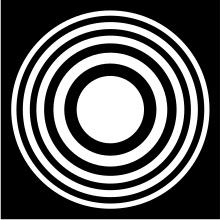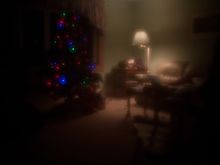Fresnel zone plate
A Fresnel zone plate , also known as zone lens , diffraction lens or kinoform , is a plate on which concentric rings are attached. The zones differ in their transparency and / or in their optical path length . In one case, the radiation is diffracted at the annular gaps and amplified by constructive interference in focal points. In the other case, the zones shown in black in the adjacent figure are replaced by a transparent material of a precisely defined thickness, which causes a phase shift of the light wave of 180 °, whereby the transmitted radiation of these zones can also interfere constructively at the focal point.
In addition to light, zone plates are used to focus X-rays because X-ray lenses are very inefficient. For a long time the manufacture of so-called refractive X-ray lenses was even considered impossible.
The Fresnel zone lens has only the inventor in common with a Fresnel lens . Both were developed by Augustin-Jean Fresnel . The Fresnel zone lens can be viewed as a cross-section through the Fresnel zones , which explains its name.
In a zone plate with binary gradation, i.e. completely transparent alternating with totally absorbing (top picture), the incident light is distributed over many real and virtual focal points (see below). In order to concentrate the light on the two focal points of the first order, only a sinusoidal contrast change is required (lower picture). The corresponding lens resembles the diffraction pattern of a circular disk . Differences in the distances between the maxima result from the different imaging method: There is so-called Fraunhofer diffraction with radiation from infinity (which is focused by lenses), here so-called Fresnel diffraction .
Calculation of the zones
For constructive interference in a focus, the radii of the alternating transparent and absorbing zones must satisfy the following equation in the quadratic approximation:
is there
- the serial number of the zone
- the wavelength of the radiation, e.g. B. 500 nm for light, 5 nm for X-rays
- the object width.
- the image distance, i.e. the distance from the center of the zone plate to the image
The following applies to:
and applies to the width of the narrowest, the outermost zone
This width corresponds - up to a factor of 1.22 - to the spatial resolution that can be achieved with a zone plate in microscopy if it is used in its first order of diffraction. You can see here that the resolution that can be achieved with a zone plate does not depend on the wavelength.
In 2008, the smallest zone widths were in the X-ray microscopy unused microscope zone plates around 20 nm. When using the zone plate in its m -th diffraction order is the achievable resolution but again by a factor of m higher.
These statements about the resolution are valid as long as the resulting computational resolution is not smaller than the wavelength of the radiation used.
You can also see: the width of the outermost zone decreases linearly with the diameter of the zone plate. Since the length of the zones increases linearly with the diameter , the area of the zones is constant - as long as the quadratic approximation mentioned above applies.
For infinitely large numbers of zones n , these relationships to the zone radius and zone width do not apply. The zone width then tends towards a constant width. For g = f this is the smallest achievable zone width .
example
A green luminous object (λ = 500 nm) at a great distance ( g ≫ f ) should be imaged by a zone plate, the inner radius of which is 10 mm ( n = 1). For m = 1 the first focal point is 50 m (distance plate-image), for m = 2 it is 25 m, for m = 3 it is 17 m. If the zone plate is one order of magnitude smaller (inner radius 1 mm), the focal lengths are two orders of magnitude smaller, in the example at 0.5 m, 0.25 m, etc.
application
Zone plates are used for focusing in X-ray optics , especially in X-ray microscopy , since there are no converging lenses in the frequency range with wavelengths below about 0.1 nm to 0.5 nm due to the high absorption.
In photography, zone plates can be used instead of an objective . Images recorded with zone plate optics have a characteristic appearance. The hole of a camera obscura can be understood as the inner part of a zone plate of the order m = 1.
Zone plates are also used in photographic lenses , such as the Canon EF 70-300 mm f / 4.5-5.6 DO IS USM ("DO" stands for "Diffractive Optics") or Nikon AF-S Nikkor 300mm f / 4E PF ED VR ("PF" stands for "Phase Fresnel").
In conoscopic holography , a zone plate is used to measure the roughness of a surface (distance measurement).
Meaning in holography
After its invention, the Fresnel zone plate was actually just a physical curiosity and also had no application. But with the invention of holography in 1948, the zone plate took on a whole new meaning. The Fresnel plate largely corresponds to the hologram of an individual image point if a plane wave or a spherical wave is used as the reference wave during the hologram generation. The only difference is that with the hologram, in contrast to the amplitude zone plate shown on the right, which only has transparent and absorbing zones, there are continuous and no sudden transmission transitions.
The connection also becomes clear when one considers that the Fresnel plate acts simultaneously as a diverging lens and a converging lens, i.e. That is, it has virtual and real focal points - like a hologram, which can reconstruct real and virtual images when illuminated with the reference wave used for hologram recording or its complex conjugate.
Since complex objects are nothing more than collections of image points, the interference patterns can be understood as superpositions of a large number of Fresnel zone plates.
Web links
- Zone plate . In: Lexicon of Optics . Spectrum, 1999 ( Spektrum.de ).
- Frank Richter: Basic course in experimental physics . Part C: Optics. Cape. 37.6 ( tu-chemnitz.de [PDF; 3.5 MB ] Lecture notes TU Chemnitz ).
- Arndt Last, Vladimir Nazmov, Elena Reznikova: Bundled X-ray light . In: Physics in Our Time . tape 38 , no. 4 , 2007, p. 176 , doi : 10.1002 / piuz.200601139 .
- Arndt Last: Zone plates for X-rays. Retrieved November 21, 2019 .
- Zone plate group pool. In: flickr.com. : Examples of zone plate photography
Individual evidence
- ↑ Zone Plates . In: X-Ray Data Booklet . Center for X-ray Optics and Advanced Light Source, Lawrence Berkeley National Laboratory, (accessed February 8, 2016).
- ↑ The Future is Flat (For Lenses) , California Institute of Technology , Pasadena, December 22, 2016, accessed January 17, 2017
- ↑ Canon EF 70-300mm f / 4.5-5.6 DO IS USM , canon.de, accessed on January 17, 2017
- ↑ AF-S NIKKOR 300 mm 1: 4E PF ED VR , nikon.de, accessed on January 17, 2017













